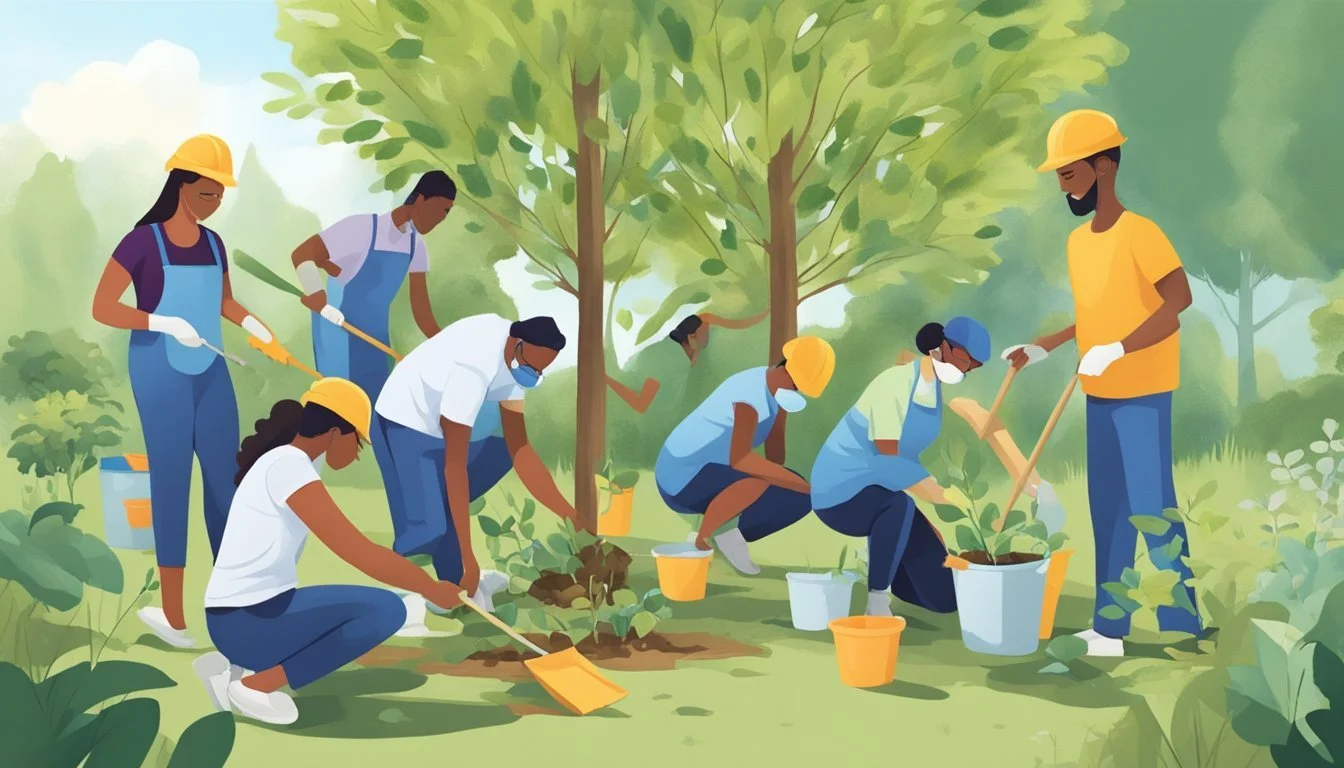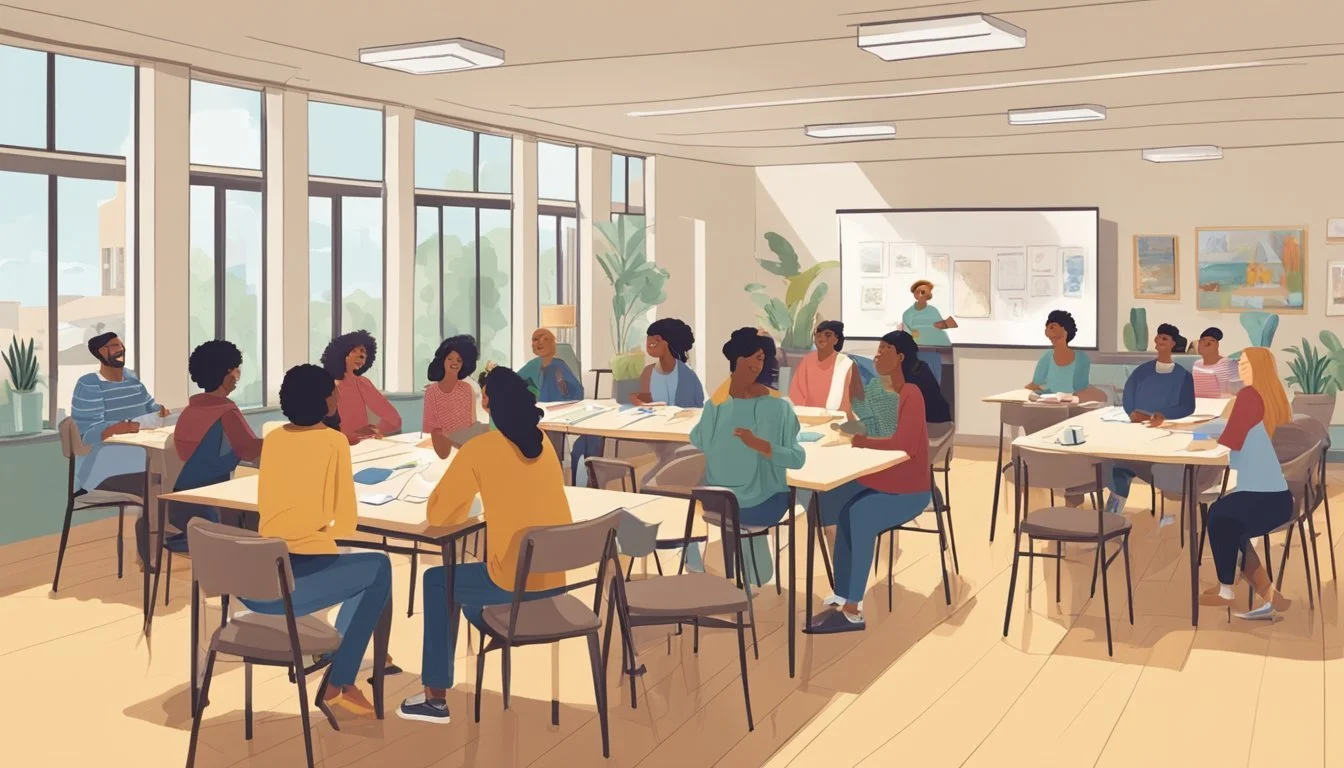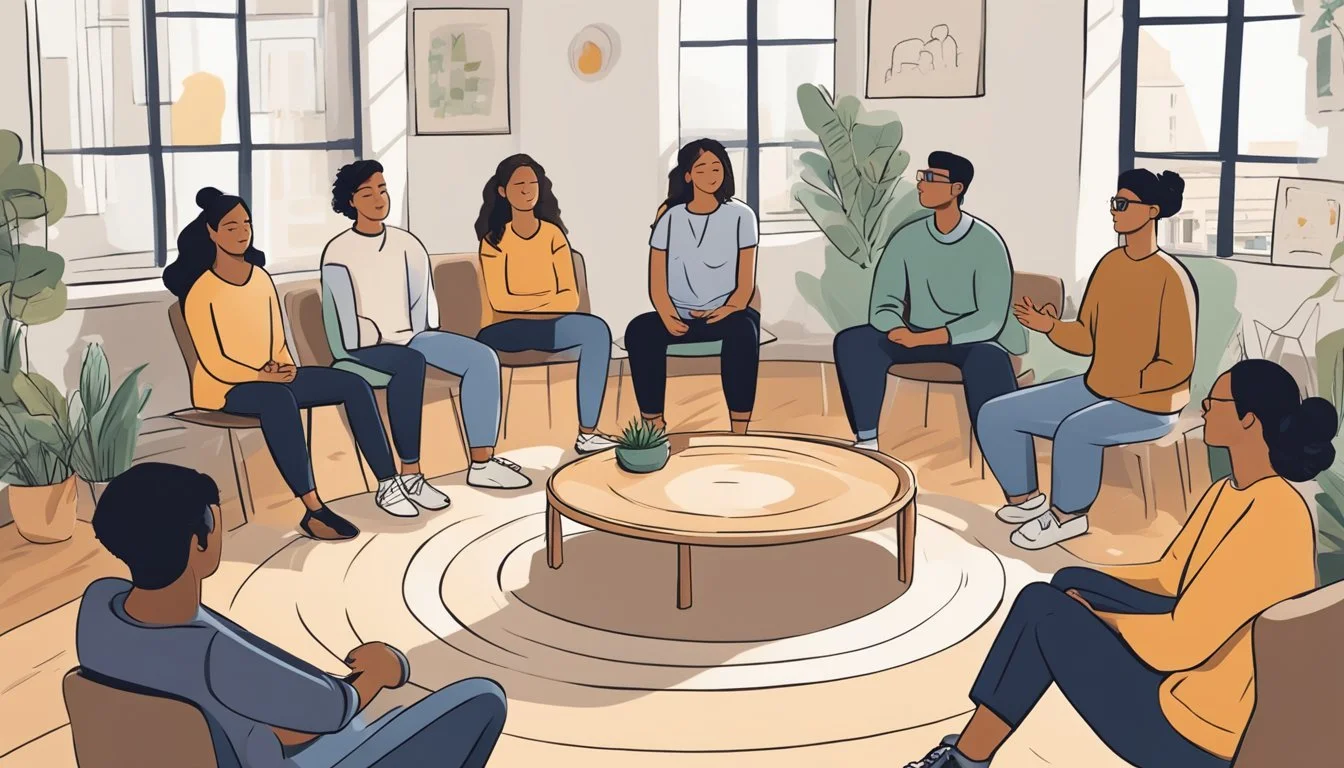10 Strategies for Rebuilding Social Connections After Trauma
Practical Tips for Healing and Growth
Rebuilding social connections after trauma can be an essential part of the healing process. Trauma can significantly impact one's ability to trust and communicate, making it challenging to form and maintain relationships. Understanding how to navigate these challenges is crucial for fostering meaningful and resilient connections.
Various strategies can aid individuals in reconnecting with others post-trauma, enhancing their social and emotional well-being. Resources and therapeutic approaches provide valuable insights into rebuilding trust and communication skills. By learning and implementing these strategies, individuals can embark on a journey towards healthier and more fulfilling relationships.
1) Join a Support Group
Being part of a support group can significantly aid in the recovery process after experiencing trauma. It provides a safe space where individuals can share their experiences and hear others' stories.
Support groups often help to alleviate feelings of isolation. By connecting with others who have faced similar challenges, individuals can regain a sense of community and belonging.
Support groups can also offer practical advice and coping strategies. Participants can learn from each other’s successes and setbacks, providing valuable insights into managing their own recovery journey.
Many support groups are facilitated by trained professionals. This ensures that discussions remain constructive and that participants have access to expert guidance.
Joining a support group is a concrete step toward rebuilding social connections. This can be particularly beneficial for those who find it difficult to discuss their trauma with friends or family.
Some support groups focus specifically on different types of trauma. This allows individuals to connect with others who truly understand their specific struggles.
For those interested in exploring support groups, numerous resources exist online to help locate a group that fits their needs. Engaging with a support group can be a vital part of the healing process.
2) Reconnect with Old Friends
Reconnecting with old friends can provide a sense of comfort and familiarity. It can be a therapeutic step toward rebuilding social connections after experiencing trauma.
One approach is to start with a simple message or call. This direct contact can open up the lines of communication in a gentle and non-intrusive manner.
It's helpful to acknowledge the past. Being open about wanting to reconnect and perhaps discussing why the contact faded might make the process more transparent and meaningful.
Seeking shared activities can also help rekindle bonds. Whether it's a hobby or a favorite past-time, engaging in mutual interests can create an easy bridge back to friendship.
For those who feel apprehensive, connecting with a therapist may be beneficial. A therapist can offer guidance on how to approach the reconnection, communicate effectively, and build healthier relationships. More tips can be found on BetterHelp.
Letters or written notes provide another alternative. This method allows the other person the space to respond when they are ready, which can be less overwhelming than direct contact. More information can be found at Join Cake.
Reconnecting with old friends after trauma requires patience, empathy, and a willingness to rebuild trust. Engaging in conversations with an open heart and mind can lay a strong foundation for renewed friendships.
3) Attend Social Events
Attending social events can be a pivotal step in re-establishing social connections after experiencing trauma. Engaging with others in social settings helps foster a sense of community and belonging.
Participating in activities like community gatherings, support groups, or social clubs provides opportunities to meet new people and reconnect with existing friends. These environments are often supportive and understanding, making it easier to open up.
It's beneficial to start with smaller events where the atmosphere is more relaxed. Smaller settings can be less overwhelming and allow for more meaningful interactions.
Choosing activities based on personal interests can also make attending these events more enjoyable. Whether it’s a hobby class, a book club, or a sports team, engaging in shared activities can help build common ground.
Socializing in these contexts can gradually build confidence and comfort in interacting with others. This approach can eventually lead to attending larger events as comfort levels increase. Attending social events regularly can become an integral part of the healing process.
For tips on navigating social dynamics after trauma, the article Navigating Relationships after Trauma offers useful insights.
4) Practice Active Listening
Active listening is crucial in rebuilding social connections after trauma. It involves fully focusing on the speaker, understanding their message, and responding thoughtfully. This skill demonstrates empathy and validation, helping individuals feel heard and supported.
Maintaining eye contact and nodding can show attentiveness. Avoid distractions like checking your phone or interrupting. This level of engagement builds trust and strengthens relationships.
Reflecting back what the speaker says also clarifies understanding. Phrases like "What I hear you saying is..." confirm that you are actively engaged and comprehending their message.
Asking open-ended questions encourages the speaker to share more. Questions such as "How did that experience make you feel?" foster deeper dialogue.
Active listening is especially important for those recovering from trauma, as it helps reduce anxiety and provides a sense of connection. It can be one of the most powerful tools in offering support, as noted in insights from Trauma Free World.
Engaging in active listening promotes empathy and understanding, which are vital components in any healing process. It's a simple yet effective way of showing genuine care and support.
By incorporating these techniques, individuals not only improve their communication skills, but also contribute to a more supportive and connected environment.
In a trauma-informed context, active listening helps both the listener and the speaker. It allows for shared space where emotions and experiences can be freely expressed and validated. Techniques such as maintaining eye contact and asking open-ended questions can be very effective in this setting, as highlighted in Solymar Online Therapy.
5) Understand Personal Boundaries
Establishing personal boundaries after trauma is crucial for mental and emotional wellness. It involves recognizing and respecting one's own limits and understanding the importance of self-care.
Individuals must identify their needs and preferences when it comes to interactions and relationships. Determining what feels safe and comfortable helps in maintaining healthy connections.
Communicating boundaries clearly to others is essential. This transparency fosters mutual respect and understanding in relationships.
Healthy boundaries also require consistency. Upholding them ensures that personal limits are respected over time.
For those in therapy, maintaining clear boundaries with trauma clients is vital to foster trust and safety, as explained by Trauma Treatment Collective.
It’s important to be patient and compassionate with oneself during this process. Rebuilding after trauma takes time, and respecting one's own boundaries plays a significant role in healing.
6) Engage in volunteer work
Volunteering can be a powerful way to rebuild social connections after experiencing trauma. It provides a structured environment where individuals can connect with others while contributing positively to their community.
Participating in volunteer activities allows for meaningful interactions. Volunteers share a common goal, which can help in forming new friendships and reinforcing a sense of belonging.
Using trauma-informed communication in volunteer settings enhances these benefits. This approach involves training volunteers to understand and recognize trauma-related behaviors, making it easier for all participants to feel safe and supported.
Additionally, volunteering in trauma-sensitive environments can help build trust and social cohesion. It allows individuals to gradually overcome feelings of isolation by being part of a supportive and empathetic community.
Organizations often tailor volunteer opportunities to accommodate diverse needs. For instance, they may offer flexible schedules or create roles that match various skill levels. This inclusivity ensures everyone can participate irrespective of their trauma history.
Engaging in volunteer work not only benefits the individual but also strengthens the community as a whole. Acts of service foster a culture of mutual aid and solidarity, contributing to a resilient and connected society.
To explore more on volunteer engagement through trauma-informed communication, visit Realized Worth.
7) Start a Hobby Class
Starting a hobby class can be a rewarding way to rebuild social connections after trauma. Engaging in an activity that interests you can help shift focus from past distress to the present moment.
Group settings like art, cooking, or fitness classes naturally foster interaction and collaboration. Participants can share experiences and support each other's progress.
Learning a new skill can also boost self-confidence. Mastering a technique or craft can provide a sense of accomplishment and personal growth.
Participating in a hobby class regularly establishes routine and structure. This consistency can be comforting and offer a sense of stability.
Joining a hobby class can help create a supportive community. Interacting with others who share similar interests provides an opportunity to form meaningful connections.
8) Seek Professional Help
Seeking professional help can be a crucial step in rebuilding social connections after trauma. Therapists and counselors are trained to guide individuals through the healing process.
They provide a safe space to explore feelings and experiences. This safe environment can be essential for regaining trust and confidence in social interactions.
Mental health professionals might use various therapies, including cognitive-behavioral therapy (CBT) or eye movement desensitization and reprocessing (EMDR). These therapies can help process traumatic experiences and reduce their ongoing impact on social behaviors.
Professionals can also assist with setting realistic goals and creating a structured plan for re-engaging in social activities. This structured approach can make social reintegration more manageable and less overwhelming.
Support groups, often facilitated by a professional, offer another valuable resource. Sharing experiences with others who have faced similar challenges can foster a sense of community and belonging.
Reaching out to a professional demonstrates a commitment to self-improvement and healing. It is an important step in forming healthier and more meaningful social connections.
Start by researching qualified professionals in your area. Look for therapists with experience in trauma recovery to ensure they understand your specific needs and can offer appropriate support.
Finding a good fit may take time, so be patient and persistent. Consistent professional support can significantly enhance the journey toward rebuilding social connections.
9) Join online communities
Participating in online communities can be a valuable step in rebuilding social connections after experiencing trauma.
These virtual platforms offer a safe space to interact with others who may have similar experiences. This shared understanding can foster a sense of camaraderie and belonging.
There are numerous forums and social media groups dedicated to trauma recovery and support. Platforms like Reddit, Facebook, and specialized therapy websites host active communities where members can share their stories, seek advice, and offer support.
Engaging with these communities can help in normalizing one's feelings and experiences. Reading others' journeys and insights can be both comforting and educational, providing new coping strategies and perspectives.
Privacy and anonymity offered by online communities allow individuals to share more openly than they might in face-to-face settings. This can be particularly beneficial for those who are not yet ready to discuss their trauma in person.
Additionally, joining these groups can help build confidence in rebuilding trust and connection, which can later translate to real-world interactions. It’s a gradual process of stepping out of isolation and re-engaging with society.
Exploring online communities such as trauma-focused forums, mental health support groups, and therapy networks like All of You Therapy and Psycle Health can be highly beneficial. These platforms provide structured discussions and can be a non-threatening first step towards reconnecting with others.
10) Attend Mindfulness Sessions
Attending mindfulness sessions can provide immense benefits for individuals recovering from trauma. These sessions teach participants to focus on the present moment, reducing feelings of anxiety and distress. Mindfulness practices encourage individuals to observe their thoughts and emotions without judgment, fostering a sense of calm and stability.
Mindfulness helps in building emotional resilience. Regular practice can improve one's ability to manage stress and maintain emotional balance. It also aids in recognizing and understanding personal triggers, which is essential for anyone working to rebuild their social connections.
Trauma-sensitive mindfulness, a practice specifically tailored to trauma survivors, can be particularly beneficial. This approach acknowledges the unique challenges faced by trauma survivors and adapts traditional mindfulness techniques accordingly. Information on trauma-sensitive mindfulness techniques can be found at Society for Psychotherapy.
Engaging in mindfulness sessions with a trauma-informed perspective allows individuals to feel safe and supported. Shared experiences in group settings can also help in rebuilding trust and enhancing interpersonal relationships. For further reading on trauma-informed mindfulness, you can refer to Psych Central.
Overall, mindfulness sessions offer a structured way to process trauma and improve social connections gradually and thoughtfully.
Understanding Trauma and Its Impact
Trauma affects individuals in profound ways, influencing their emotional and psychological states, and creating significant challenges in forming and maintaining social connections. Recognizing the full spectrum of trauma's impact is essential for anyone aiming to rebuild social ties after such experiences.
Defining Trauma
Trauma is a response to a deeply distressing or disturbing event that overwhelms an individual's ability to cope. These events can range from natural disasters to personal assaults and accidents. The National Institute on Mental Health categorizes trauma as potential triggers for both physical and emotional responses.
Trauma can be acute, resulting from a single event, or chronic, stemming from repeated and prolonged exposure to stressful situations, such as abuse or violence. Trauma may also be complex, involving multiple layers and types of trauma over time. Understanding these distinctions is critical to addressing the specific needs of trauma survivors.
Emotional and Psychological Effects
Trauma leaves lasting marks on an individual’s emotional and psychological well-being. Common effects include anxiety, depression, and post-traumatic stress disorder (PTSD), characterized by intrusive memories, hypervigilance, and difficulty in concentrating. These responses are rooted in the brain's reaction to traumatic events, altering neural pathways and emotional regulation systems.
Fear of vulnerability and a heightened need for control are also prevalent, complicating personal interactions and trust. Emotional numbness and difficulty in expressing feelings often follow, making social engagement challenging. Recognizing these signs is vital for providing adequate support to trauma survivors.
Challenges in Social Connections
Trauma significantly impacts an individual's ability to form and maintain social connections. Hypervigilance and mistrust are common, leading to withdrawal from social interactions. Survivors might struggle with communication, finding it hard to articulate their emotions or needs. This can lead to misunderstandings and strained relationships.
Building trust is another major hurdle. As highlighted in strategies for rebuilding trust after trauma, addressing unresolved trauma is crucial. Empathy and support from loved ones play a key role in this journey. Establishing a safe and understanding environment can help survivors gradually rebuild their social connections effectively.
Effective Communication Strategies
Effective communication is essential for rebuilding social connections after trauma. Key strategies include practicing active listening and being mindful of non-verbal cues to enhance understanding and support.
Active Listening
Active listening involves fully concentrating on what another person is saying rather than just passively hearing the message. This means giving one's full attention, responding thoughtfully, and avoiding interruptions.
Listeners should use affirmations such as "I understand," making eye contact, and nodding to show they are engaged. Asking open-ended questions encourages the speaker to share more details, which can lead to deeper understanding. Paraphrasing what the speaker has said also demonstrates that the listener is attentive and values their perspective.
Implementing these techniques helps build trust and validation in any conversation, particularly when dealing with the sensitive aftermath of trauma.
Non-Verbal Communication
Non-verbal communication plays a significant role in conveying empathy and support. Body language, facial expressions, and gestures can significantly impact the quality of interactions.
Maintaining appropriate eye contact shows attention and concern, while facial expressions such as a gentle nod or a smile can reassure the speaker. Posture is also important; an open and relaxed stance indicates receptiveness and warmth.
Touch, when appropriate and consensual, can be a powerful tool for conveying support and solidarity. For instance, a comforting pat on the back or a gentle hand squeeze can communicate empathy more effectively than words.
By being mindful of these non-verbal cues, individuals can improve their communication and foster stronger connections, which are crucial in healing and rebuilding after trauma.
Building Trust and Safety
Rebuilding trust and creating a sense of safety post-trauma is fundamental for fostering healthy social connections. The following strategies focus on creating environments conducive to trust and establishing clear boundaries to ensure emotional security.
Creating Safe Spaces
A safe space offers an environment where individuals feel protected, respected, and free to express themselves without fear of judgment. To create such an environment, it is reassuring to establish consistent routines and foster open communication.
Consistency can provide a sense of predictability, which is particularly soothing for those recovering from trauma. Maintaining regular meet-ups or activities helps to instill this consistency.
Open communication involves actively listening, validating feelings, and being empathetic. Asking for and respecting preferences regarding how and when to discuss sensitive topics can significantly contribute to a feeling of safety. Encouraging honesty and assuring confidentiality builds a solid foundation of trust.
Creating physical settings that are calm and comfortable also plays a crucial role. This might include quiet meeting places or ensuring that the ambience is non-threatening.
Establishing Boundaries
Setting and respecting boundaries is paramount to feeling safe and secure in social interactions. Boundaries help individuals regain control and protect their well-being.
Clear communication about personal limits is essential. It’s vital for both parties to articulate what they are comfortable with in terms of topics of discussion, physical space, and engagement level. This mutual understanding prevents overstepping personal limits and reduces the risk of re-traumatization.
Empathy comes into play here as well. Respecting the boundaries laid out by someone recovering from trauma demonstrates that their feelings and comfort are a priority.
Reliably honoring commitments and promises also reinforces trust. If a boundary or agreement is set, adhering to it confirms that the individual’s needs are being taken seriously. This consistency can foster a stronger sense of security and trust over time.
Empowering individuals by involving them in decisions related to their boundaries builds confidence and autonomy, essential elements in rebuilding trust and safety.








